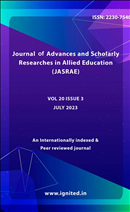Study of Riparian Plant Species Diversity of Sidhi, Madhya Pradesh
Keywords:
riparian plant species diversity, Sidhi, Madhya Pradesh, pollution, Son river, Banas river, Gopad river, gopaldas dam, goriyara dam, Rehi riverAbstract
The water in the Son, Banas, Gopad, gopaldas dam, goriyara dam and Rehi river has longbeen revered for its purity, but recent years have seen a steady decline in quality as a result ofunchecked human activity. In the riparian zones, the physiochemical interactions between the terrestrialand aquatic ecosystems are particularly significant. This article uses a winter and summer of 2022riparian vegetation analysis to assess pollution in the Son, Banas, Gopad, gopaldas dam, goriyara damand Rehi river in Madhya Pradesh (M.P.). The average values of the Simpson's diversity index (SDI) andthe Shannon-Weiner diversity index (SWDI) were between 0.23 and 0.28, indicating that this part of theSon, Banas, Gopad, gopaldas dam, goriyara dam and Rehi river is in good health. The river is inmoderate health, as shown by the Margalef richness index (MARI) values of 0.49 to 0.52 and the Menhinikrichness index (MERI) values of 0.08 to 0.11. Therefore, numerous indices, including the NationalSocioeconomic Status and Quality Index (NSFWQI), the Composite Tropical Stability Index (CTSI), andthe Stability Index (SDI), have been used to investigate Son, Banas, Gopad, gopaldas dam, goriyara damand Rehi river's ecological status. The findings demonstrate that ecological well-being is often between a2 and 3. Furthermore, the data show that diversity and richness indices rise from winter to summer,indicating lower pollution levels in the summer. Taking corrective measures to manage the seasonalincrease in pollutants is essential to maintaining excellent water quality throughout the duration.Because of the area's middling ecological health, the water is unfit for human consumption but suitablefor irrigation, bathing, aquaculture, and life support.References
Riparian Flora of Mahi River, Gujarat Amita O. Sankhwal, Shruti D. Shah, Deepa J. Gavali and Sumesh N. Dudani (2015) ISSN (online): 2320-4257
Brandt, E.C.; Petersen, J. E.; Grossman, J. J.; Allen, G.A.; Benzing, D.H. 2015.Relationships between spatial metrics and plant diversity in constructed freshwater wetlands, 10(8).
Faxina. C, Fisher. E, and Pott. A. 2015.Flora of inland Atlantic riparian forests in Southwestern Brazil. Biota Neotropica. 15 (3); 1-12.
van looy, Kris & Tormos, T. & Souchon, Yves & Gilvear, David. (2017). Analyzing riparian zone ecosystem services bundles to instruct river management. International Journal of Biodiversity Science, Ecosystem Services and Management. 13. 10.1080/21513732.2017.1365773.
Karthika T & Mary Kensa V Aegaeum journal Volume 8, Issue 11, 2020 http://aegaeum.com/ ISSN NO: 0776-3808 (2020). Riparian flora.
Lavorel S, Bayer A, Bondeau A, Lautenbach S, Ruiz-Frau A, Schulp N, Seppelt R, Verburg P, van Teeffelen A, Vannier C, et al. 2017. Pathways to bridge the biophysical realism gap in ecosystem services mapping approaches. Ecol Indic. 74:241–260.
Liquete C, Kleeschulte S, Dige G, Maes J, Grizzetti B, Olah B, Zulian G. 2015. Mapping green infrastructure based on ecosystem services and ecological networks: a Pan European case study. Environ Sci Policy. 54::268-280.
Liquete C, Maes J, La Notte A, Bidoglio G. 2011. Securing water as a resource for society: an ecosystem services perspective. Ecohydrology & Hydrobiology. 11:247–259.
Luisetti T, Turner RK, Bateman IJ, Jones SM, Adams C, Fonseca L. 2011. Coastal and marine ecosystem services valuation for policy and management: managed realignment case studies in England. Ocean Coast Manag. 54:212–224.
Maes J, Egoh B, Willemen L, Liquete C, Vihervaara P, Schägner JP, Grizzetti B, Drakou EG, Notte AL, Zulian G, et al. 2012. Mapping ecosystem services for policy support and decision making in the European Union. Ecosystem Serv. 1:31–39.
McCluney KE, Poff NL, Palmer MA, Thorp JH, Poole GC, Williams BS, Williams MR, Baron JS. 2020-2022. Riverine macrosystems ecology: sensitivity, resistance, and resilience of whole river basins with human alterations. Front Ecol Environ. 12:48–58.
McVittie A, Norton L, Martin-Ortega J, Siameti I, Glenk K, Aalders I. 2015. Operationalizing an ecosystem services-based approach using Bayesian Belief Networks: an application to riparian buffer strips. Ecological Econ. 110:15–27.
Mitchell ME, Bennett E, Gonzalez A. 2013. Linking landscape connectivity and ecosystem service provision: current knowledge and research gaps. Ecosystems. 16:894–908.
Moilanen A, Anderson BJ, Eigenbrod F, Heinemeyer A, Roy DB, Gillings S, Arms worth PR, Gaston KJ, Thomas CD. 2011. Balancing alternative land uses in conservation prioritization. Ecological Appl. 21:1419–1426.
Mouchet MA, Lamarque P, Martín-López B, Crouzat E, Gos P, Byczek C, Lavorel S. 2020-2022. An interdisciplinary methodological guide for quantifying associations between ecosystem services. Glob Environ Change. 28::298-308.











